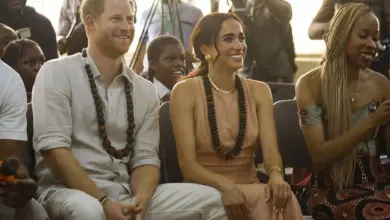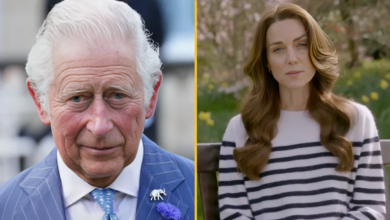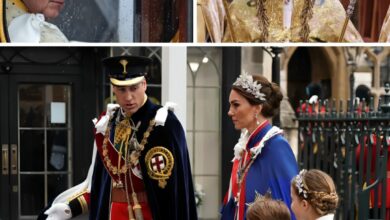Why Kate Middleton Nearly Turned Down Diana’s Princess Title?


The British Royal Family has long captivated the world’s attention, and few figures have garnered as much interest as Kate Middleton, now known as Catherine, Princess of Wales. Her journey from commoner to future queen consort has been nothing short of remarkable, but recent revelations suggest that her path to becoming Princess of Wales was not without its challenges and hesitations. This article delves deep into Kate’s relationship with the iconic title once held by her late mother-in-law, Princess Diana, and explores the complexities of stepping into such a revered role.
The Weight of a Royal Title
The title of Princess of Wales carries with it a rich history and immense public scrutiny. For Kate Middleton, accepting this title meant not only embracing her role as future queen consort but also inviting inevitable comparisons to the beloved Princess Diana.
The Legacy of Diana, Princess of Wales
Princess Diana’s tenure as the Princess of Wales left an indelible mark on the British monarchy and the world at large. Her charisma, humanitarian efforts, and tragic death cemented her status as a cultural icon. For any woman following in her footsteps, the pressure to live up to her legacy would be immense.
Diana’s approach to royal life was revolutionary. She brought a warmth and accessibility to the monarchy that had not been seen before. Her work with AIDS patients, landmine victims, and other marginalized groups showcased a compassion that endeared her to millions worldwide.
The media’s obsession with Diana was unparalleled, and her every move was scrutinized. This intense spotlight contributed to the breakdown of her marriage to Prince Charles and ultimately played a role in the tragic circumstances of her death.

The Public’s Expectations
With Diana’s legacy looming large, the public’s expectations for the next Princess of Wales were understandably high. Many wondered if anyone could ever fill the void left by Diana’s passing.
The British public, in particular, held a deep affection for Diana and viewed her as the “People’s Princess.” This created a challenging environment for Kate, as she would inevitably be compared to a figure who had achieved near-mythical status.
Media outlets and royal watchers were quick to draw parallels between Kate and Diana, from their fashion choices to their public personas. This constant comparison added an extra layer of pressure to Kate’s royal duties.
The Evolution of Royal Titles
The title of Princess of Wales is not automatically bestowed upon the wife of the Prince of Wales. It is a courtesy title that can be used, but is not mandatory. This flexibility allowed for some precedent in how the title could be approached.
When Camilla Parker Bowles married Prince Charles in 2005, she opted not to use the title Princess of Wales out of respect for Diana’s memory. Instead, she chose to be known as the Duchess of Cornwall, her husband’s secondary title.
This decision by Camilla provided a potential blueprint for Kate, should she have chosen to avoid the Princess of Wales title. It demonstrated that there was room for flexibility within the royal naming conventions.

Kate’s Journey to Royalty
Kate Middleton’s transformation from a middle-class girl from Berkshire to a key member of the British Royal Family is a story that has captivated millions. Her journey provides context for her eventual decision regarding the Princess of Wales title.
Early Life and Education
Catherine Elizabeth Middleton was born on January 9, 1982, to Michael and Carole Middleton. Unlike many who have married into the royal family, Kate came from a solidly middle-class background.
Kate’s childhood was marked by a close-knit family life and a good education. She attended private schools, including the prestigious Marlborough College, where she excelled in sports and academics.
After completing her secondary education, Kate enrolled at the University of St Andrews in Scotland. It was here that her path would intersect with that of Prince William, setting the stage for their future together.
Meeting Prince William
Kate and William’s relationship began as a friendship during their time at St Andrews. They shared a house with other students, which allowed them to get to know each other away from the public eye.
Their romantic relationship became public knowledge in 2004, thrusting Kate into the spotlight. The media’s interest in her was immediate and intense, giving her a taste of the scrutiny she would face as a member of the royal family.
Throughout their courtship, Kate displayed a remarkable ability to handle the press attention with grace and discretion. This period was crucial in preparing her for the role she would eventually take on within the monarchy.

The Royal Wedding and Early Years of Marriage
After a brief separation in 2007, Kate and William’s relationship strengthened, leading to their engagement in 2010. Their wedding on April 29, 2011, was a global event, watched by millions around the world.
Upon marriage, Kate received the title of Duchess of Cambridge. This period allowed her to ease into royal life without the immediate pressure of being Princess of Wales.
During the early years of their marriage, Kate and William focused on building their family and gradually increasing their royal duties. This time was crucial for Kate to find her footing within the royal family and to develop her own areas of interest and patronages.
The Dilemma of the Princess of Wales Title
When King Charles ascended to the throne in September 2022, the question of Kate’s title came to the forefront. The decision to accept or decline the Princess of Wales title was not one to be taken lightly.
The Emotional Burden
For Kate, considering the Princess of Wales title meant confronting the emotional weight associated with Diana’s legacy. The constant comparisons to her late mother-in-law had been a source of stress throughout her royal life.
The prospect of stepping into a role so intimately connected with Diana’s memory was undoubtedly daunting. Kate had to weigh the honor of the title against the potential emotional toll it could take.
There was also the consideration of how accepting the title might affect William, who had lost his mother at such a young age. The decision would inevitably bring Diana’s memory to the forefront once again.

Public Perception and Media Scrutiny
Accepting the Princess of Wales title would inevitably intensify media scrutiny of Kate. Every action, every outfit, and every public appearance would be analyzed and compared to Diana’s.
Kate had to consider how this increased attention might affect her ability to carry out her royal duties effectively. There was a risk that the constant comparisons could overshadow her own initiatives and charitable work.
On the other hand, declining the title could be seen as a rejection of Diana’s legacy or an unwillingness to fully embrace her role within the royal family. Kate had to navigate these complex public perception issues carefully.
The Impact on Royal Tradition
The decision regarding the Princess of Wales title had implications beyond Kate’s personal feelings. It would set a precedent for future generations and potentially impact the way royal titles are viewed and used.
Kate had to consider her role in maintaining royal traditions while also modernizing the monarchy. Accepting the title could be seen as upholding tradition, while declining it might be viewed as a step towards a more streamlined royal family.
There was also the question of how her decision might affect her children’s futures, particularly Princess Charlotte, who may one day hold the title herself.

Kate’s Decision and Its Implications
Ultimately, Kate chose to accept the title of Princess of Wales, a decision that has had far-reaching implications for both her personal life and her role within the monarchy.
Embracing the Role
By accepting the title, Kate demonstrated her commitment to her position within the royal family and her willingness to take on the responsibilities that come with it.
This decision allowed for continuity in the royal lineage and maintained the traditional progression of titles within the monarchy. It also provided a sense of stability during a time of significant change following Queen Elizabeth II’s passing.
Kate’s acceptance of the title has given her a platform to continue and expand her charitable work, particularly in areas such as early childhood development and mental health awareness.
Carving Her Own Path
While accepting the Princess of Wales title, Kate has been careful to establish her own identity within the role. She has focused on causes that are personally meaningful to her, rather than simply replicating Diana’s work.
Kate’s approach to royal duties has been characterized by a quiet determination and a focus on substance over spectacle. This has helped her to differentiate herself from Diana’s more high-profile style.
By balancing respect for tradition with her own modern approach, Kate has begun to redefine what it means to be the Princess of Wales in the 21st century.

Public Response and Media Reaction
The public reaction to Kate’s new title has been largely positive. Many have praised her for honoring Diana’s memory while also establishing her own unique presence as Princess of Wales.
Media coverage has inevitably drawn comparisons between Kate and Diana, but there has also been recognition of Kate’s individual strengths and contributions to the royal family.
Kate’s handling of the increased attention has been commended, with many noting her poise and professionalism in the face of intensified scrutiny.
The Future of the Princess of Wales
As Kate settles into her role as Princess of Wales, the focus turns to how she will shape the title and its significance in the years to come.
Defining Her Legacy
Kate has the opportunity to create a lasting legacy as Princess of Wales. Her focus on early childhood development and mental health awareness has the potential to make a significant impact on society.
As she continues in this role, Kate will likely expand her charitable work and take on more high-profile duties representing the monarchy both at home and abroad.
The way Kate balances her roles as a mother, a royal, and a public figure will undoubtedly influence how future generations view the position of Princess of Wales.

Preparing for Queenship
The title of Princess of Wales is traditionally held by the wife of the heir apparent to the British throne. As such, Kate’s current role is also preparation for her future position as Queen Consort.
Kate’s approach to her duties as Princess of Wales will set the tone for her eventual reign alongside William. Her ability to connect with the public and represent the monarchy with dignity will be crucial in maintaining the relevance and popularity of the royal family.
As she looks to the future, Kate must balance the weight of tradition with the need for the monarchy to evolve and remain relevant in a changing world.
Influencing the Next Generation
Kate’s tenure as Princess of Wales will have a direct impact on her children, particularly Princess Charlotte, who may one day hold the title herself.
Through her actions and choices, Kate is setting an example for her children about the responsibilities and expectations that come with royal life.
Kate’s approach to balancing family life with royal duties will likely influence how future generations of royals navigate their public and private roles.

Conclusion
Kate Middleton’s journey to becoming the Princess of Wales has been marked by both hesitation and determination. Her initial reluctance to take on a title so deeply associated with Princess Diana reveals the complex emotions and pressures that come with royal life. However, Kate’s ultimate decision to embrace the role demonstrates her commitment to the monarchy and her willingness to forge her own path within its traditions.
As she continues to define what it means to be the Princess of Wales in the modern era, Kate faces the challenge of honoring Diana’s legacy while establishing her own unique identity. Her focus on early childhood development, mental health, and other critical social issues shows a dedication to using her position for meaningful change.
The coming years will undoubtedly bring new challenges and opportunities for Kate as Princess of Wales. How she navigates these will not only shape her own legacy but also influence the future of the British monarchy. As she balances the weight of history with the demands of the present, Kate Middleton is poised to leave her own indelible mark on the role of Princess of Wales, carrying it forward into a new era with grace, purpose, and her own distinct style.





